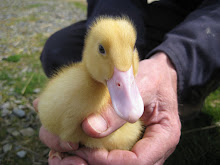 This is something a friend told me about, and well, I struggled to believe her. But now I've seen it for myself.
This is something a friend told me about, and well, I struggled to believe her. But now I've seen it for myself.It's been around for some years now, but even though the South West has more farms than anywhere else in the country, there are just 20 robot milking parlours in the whole region.
What's it all about then?
Basically, the cow determines when it wants milking (aided by greed as the robot supplies food too), and hops onto the unit which then takes control with no-one needing to be present. First the computer notes which cow it has in its clutches from the transmitter hung round her neck. The gate closes to keep her secure, and a warm steamy wash with clever little rollers brushes up and down each teat, just like a miniature car wash. Seeing it in action last night at a local farm I suggested that particular function might have been invented by Ann Summers. Next, the laser comes into action to precisely determine where the teats are before docking the cups to them. If the cow shifts a little, the lasers recalibrate and have another go. If only 3 quarters are in action, the computer knows that too. Then the milking starts. Each quarter of the udder is milked independently, so the machine stops milking each one when it is empty. Meanwhile, the computer is analysing just about everything: milk flow; temperature; quantity of milk produced from each quarter; number of times the cow has presented herself for milking; whether the cow is about to come down with mastitis; if it's been milked a couple of hours ago and needs shoving out and not milking; you name it.
The cows take themselves through a non return gate when they want a little steaming, brushing and milking, otherwise they are free to help themselves elsewhere in the cow shed to feed, a lie down or a relaxing scratch from the automatic cow brush. Although the farm I visited keeps the cows indoors, you can certainly include fresh grazing into the system by enabling recently milked cows access to outdoor grazing.
It was an incredibly intelligent system, requiring minimal labour, and providing the farmer with everything you need to know about your cow, enabling swift preventative care. It also sends phone alerts if there is a problem of any kind, with clear messages that describes exactly what requires attention. Up to a week is needed to acclimatise each cow, and the system clearly produces very quiet cows and gives them almost everything they need.
But although I was in awe of it all, I don't want milk from cows excluded from spring and summer natural grazing, and I'd like to see for myself a system that includes significant access to grass even if it creates a slight decrease in the milk yield. I wonder what the Soil Association view is on this.
If you are intrigued and want to see the system in action, you can watch a video here.

















13 comments:
I was totally mesmerized! Olly mentioned this to me and I said no, not possible - how about...and listed about a 100 reasons why it couldn't be done. After the video I'm eating humble pie!
Wow - would love to see it too.
It is nice to think that the cows themselves can choose when they wish to get milked, but with minimum handling perhaps they would get a bit wild?
Paula - I know, I know....so very weird. I dont think I have reservations about the robot, just about proper access to grazing. Have asked the Soil Association if they have a take on this and will post if they get back to me.
Lindsay - it seems to have the opposite effect - I walked through a complete herd of 100 cattle that took no notice of me at all - too quiet and subdued perhaps?
Very impressive and hard to believe it is do-able. (Did check the date and it is July 1st...)
How long would it take to get a herd of say 100 cows through a system like that? - or is time no longer an issue?
Ah - good point M'ear - forgot to say that the system is on 24/7, so the analysis on the computer tells you what has happened in any 24 hour period. The printout we looked at showed that cows entered on average 3.5 times a day, and it all takes about 5 minutes per cow. On that approx timeline if they all stood in line nose to tail constantly (which they don't)to enter the robot, it would take 8 hours to milk 100 cows and every cow could be milked 3 times in one day (so my 5 minute guestimate is slightly out). However, in the couple of hours we were there (8-10pm), the robot was never empty.
And I thought it was all rosy cheeked milk maids hauling on teats before repairing to the hay shed for spot of rumpy pumpy with the stable boy.
Much more wholesome if you ask me. I don't want the provenance of my milk to resemble a Ford Focus production line.
Maybe you could take the robot into your fields
Very interesting. I'd like to know what the Soil Association thinks, too.
Blimey, a milking Metal Mickey.
Whatever next?
Mopsa - I found you through Dulwich Mum's blog.I struggled with the photo which looked like a cow in a vending machine at first! My first thought was Anne Summers too. I wonder if they exist here in France? VLiF
Garfer - you have a rich imaginative life!
WW - I suspect it would go all rusty
Welshcakes - I'll let you know if they respond
SM - I think they've already done Stepford Wives...
VLiF - hi there! It was invented in Holland so I suspect you may well have them in France too.
Well, I was prepared to hate it, but ... on balance it looks quite kind and efficient! I would imagine that with more frequent milking the production would go up, too.
But yes, surely with less handling, the cows might be less handleable? And then when the vet needs to call, he'll curse that darned thing!
Jay - I'm not sure that cows in conventional milking parlours get handled any more than those in the robot. You'd have to still trim their toes etc and those robot cows were incredibly docile - they'd have to be to go into the robot in the first place.
Post a Comment